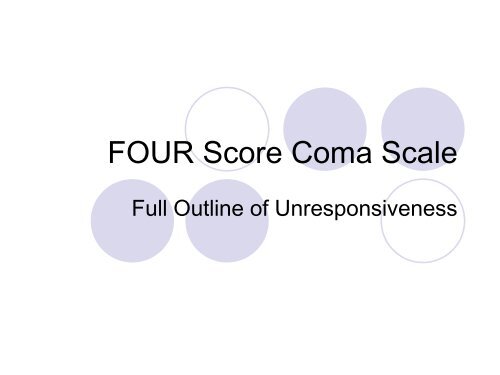FOUR Score Coma Scale - ICU
FOUR Score Coma Scale - ICU FOUR Score Coma Scale - ICU
FOUR Score Coma Scale Full Outline of Unresponsiveness
- Page 2: Geschiedenis •1974 Teasdale and J
- Page 5 and 6: FOUR
- Page 7: FOUR
- Page 10 and 11: Eye response •Differentiation bet
- Page 12 and 13: Brainstem components •Pons •Mes
- Page 14 and 15: Studie •Different types of examin
- Page 16 and 17: Outcome assessment •A robust pred
- Page 18: Rankin score 4 : Moderately severe
- Page 22 and 23: Shortcomings GCS •Verbal componen
- Page 24 and 25: FOUR: Voordelen • High degree of:
- Page 30 and 31: Limitations •4 maal: familiarity
- Page 32: Referenties • Vivek et all. Valid
<strong>FOUR</strong> <strong>Score</strong> <strong>Coma</strong> <strong>Scale</strong><br />
Full Outline of Unresponsiveness
Geschiedenis<br />
•1974 Teasdale and Jenett<br />
Attempt to bring uniformity to the clinical<br />
examination and clinical communication<br />
about the level of consciousness<br />
GCS<br />
Not designed to capture distinct details of<br />
the neurologic examination
<strong>FOUR</strong>
<strong>FOUR</strong>
<strong>FOUR</strong>
<strong>FOUR</strong>
Voordelen<br />
•Measurement of brainstemreflexes<br />
•Determination of eye opening, blinking and<br />
tracking<br />
•A broad spectrum of motor responses<br />
•Presence of abnormal breath rhythms and<br />
a respiratory drive<br />
•NO assessment of verbal responses<br />
(intubation)
Eye response<br />
•Differentiation between<br />
◦Vegetative state<br />
(eyes open but do not track)<br />
◦Locked in syndrome<br />
(eyes open, blink and track vertically on command)
Motor assessment<br />
•Combination:<br />
◦Withdrawal reflex<br />
◦Decorticate rigidity<br />
Complex command (alert)<br />
•Severe cerebral dysfunction<br />
(Myoclonic status epilepticus)
Brainstem components<br />
•Pons<br />
•Mesencephalon<br />
•Medulla oblongata<br />
Various combinations
Breathing components<br />
•Cheyne-Stokes respiration<br />
•Irregular breathing<br />
Bihemispheric or lower brainstem<br />
dysfunction<br />
Intubation: presence or absence of a<br />
respiratory drive
Studie<br />
•Different types of examiners<br />
◦ Watched a 20min instruction on the <strong>FOUR</strong><br />
score (videos with patient examples)<br />
•Exclusie sedation/neuromuscular function<br />
blockers
Studie<br />
•4 categories:<br />
◦Alert<br />
◦Drowsy<br />
◦Stuporous<br />
◦<strong>Coma</strong>tose<br />
Each patient was rated on both scales by<br />
two different raters (1 hours)
Outcome assessment<br />
•A robust predictor of:<br />
◦In-hospital mortality (withdrawal of life support)<br />
◦Functional outcome at hospital discharge<br />
•Clinical diagnosis of brain death<br />
•Morbidity at 3 months<br />
Modified Rankin <strong>Scale</strong>
Rankin score<br />
0 : No symptoms<br />
1 : No evident disability despite symptoms<br />
2 : Slight disability, with an inability to carry<br />
out all previous activities<br />
3 : Moderate disability, with the need for<br />
some help but the ability to walk without<br />
assistance
Rankin score<br />
4 : Moderately severe disability, with the<br />
inability to walk without assistance or to<br />
attend to bodily needs without assistance<br />
5 : Severe disability, with the patient being<br />
bedridden and incontinent and requiring<br />
constant nursing care<br />
6 : Death
Ideal coma scale<br />
•Reliable (measures what it is supposed to<br />
measure)<br />
•Valid (yields the same results with<br />
repeated testing)<br />
•Linear (gives all component equal weight)<br />
•Easy to use (provides simple instructions<br />
without the need for tools or cards)
Shortcomings GCS<br />
•Verbal component<br />
◦Orientation<br />
•Quickly abnormal (agitation/confusion)<br />
•Conversely no respose → alert<br />
◦Intubation<br />
•Poorly assessing patients with less severe<br />
degrees of coma
Shortcomings GCS<br />
• No assessment of brainstem reflexes<br />
(eye movements, complex motor responses)<br />
Reliability<br />
• Numerically toward motor responses<br />
Linearity<br />
• May not detect subtle changes<br />
→ Attempts to improve GCS (lengthy)
<strong>FOUR</strong>: Voordelen<br />
• High degree of:<br />
◦Internal consistency<br />
◦Interrater reliability (interobserver agreement)*<br />
• Intubated patients<br />
• Brainstem reflexes<br />
• Respiratory patterns<br />
• Further characterizes the severity of the<br />
comatose state in patients with lowest GCS<br />
(Mortality)<br />
* High proportion alert patient (ER)
<strong>FOUR</strong>: Voordelen<br />
• Detects early changes in consciousness<br />
(Acute metabolic derangements, sepsis, shock,<br />
other nonstructural brain injuries)<br />
• Frequent use of mild sedation affects:<br />
◦Eye opening<br />
◦Motor response<br />
• NOT:<br />
◦Brainstem reflexes<br />
◦Respiration.
Limitations<br />
•4 maal: familiarity<br />
•Number of patients<br />
•Nurse/nurse<br />
•Target enrollment cohort<br />
•Alert patients<br />
•Single center study
Conclusion<br />
•Easily taught, simple to administer and<br />
provides essentiel neurologic information<br />
limited experience neuroscience<br />
•‘Accurately’ predicts pour outcome<br />
•Interobserver agreement (GCS)<br />
•Detect occurence of brain death<br />
•Diagnose a locked-in syndrome
Referenties<br />
• Vivek et all. Validity of the <strong>FOUR</strong> score coma<br />
scale in the medical intensive care unit. Mayo<br />
Clinic Proc. 2009;84(8):694-701<br />
• Latha et all. Validation of a new coma scale, the<br />
<strong>FOUR</strong> score, in the emergency department.<br />
Neurocrit Care. 2009; 10:50-54<br />
• Chris et all. Further validation of the <strong>FOUR</strong> score<br />
coma scale by intensive care nurses. Mayo Clin<br />
Proc. 2007; 82(4):435-438<br />
• Eelco et all. Validation of a new coma scale: the<br />
<strong>FOUR</strong> score. Ann Neurol. 2005;58:585-593



